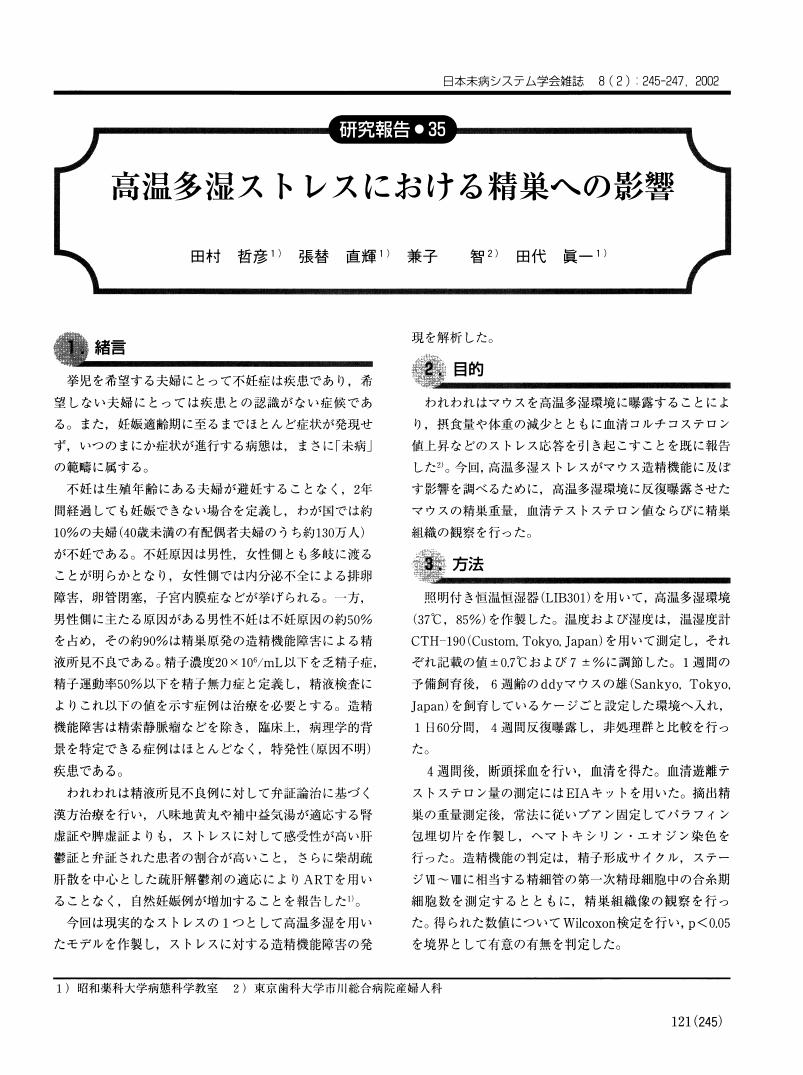2 0 0 0 OA I-B-11 夏バテ実験モデルと六君子湯の効果
1 0 0 0 OA 大建中湯エキス製剤の使用実態と剤形に関する研究
- 著者
- 浜田 幸宏 赤瀬 朋秀 田代 眞一 佐川 賢一 島田 慈彦
- 出版者
- The Japan Society for Oriental Medicine
- 雑誌
- 日本東洋医学雑誌 (ISSN:02874857)
- 巻号頁・発行日
- vol.54, no.3, pp.645-650, 2003-05-20 (Released:2010-03-12)
- 参考文献数
- 9
- 被引用文献数
- 1 1
最近, 使用量が急増している大建中湯エキス顆粒の使用実態を北里大学病院において6ヵ月間にわたり調査した。またその調査から剤形に関する問題点が浮かび上がったので大規模病院8施設において実際に服用実態を把握している看護師にアンケート調査を行った。大建中湯エキス顆粒は, 北里大学病院において, 主に婦人科および外科から処方されており, いずれも手術後が多かった。こうした患者への投薬は経管など看護師の手で行われていたことから大建中湯エキス顆粒を与薬する際に生ずる問題点を抽出する目的で行ったアンケート調査の結果, 与薬した患者からの苦情のうち8割以上は味や剤形に関する指摘であった。今回の調査において,臨床現場においてエキス顆粒という剤形の使い勝手のよくない事が明らかとなった。このことは粉砕・溶解など看護師の与薬業務に負担になっている可能性が示唆された。特に, 嚥下能力の低下した患者に投与する際にはさらに一歩すすんだ改良が必要であり, 煎剤を個別包装したスティック入り液状製剤のように, 使用性の優れた新しい漢方製剤が必要であると考えられた。
1 0 0 0 OA 植物香気成分の示す多様な作用とその臨床応用(講座:香気成分の化学 1)
- 著者
- 田代 眞一
- 出版者
- 社団法人日本化学会
- 雑誌
- 化学と教育 (ISSN:03862151)
- 巻号頁・発行日
- vol.51, no.2, pp.118-121, 2003-02-20
- 著者
- 赤瀬 智子 嶋田 努 原沢 友紀子 赤瀬 朋秀 池谷 幸信 田代 眞一 油田 正樹
- 出版者
- ライフサイエンス出版
- 雑誌
- 薬理と治療 = Basic pharmacology and therapeutics (ISSN:03863603)
- 巻号頁・発行日
- vol.36, no.1, pp.39-48, 2008-01-01
「はじめに」近年先進国において増加しているMetS(内臓脂肪症候群)は動脈硬化性疾患(心筋梗塞や脳梗塞など)の危険性を高めるマルチプルリスクファクター症候群のことである. 動脈硬化性疾患は肥満症, 高血圧症, 高脂血症, 耐糖能異常, 高インスリン血症などの代謝性疾患が重なることによって発症頻度が増加するといわれている1). 日本では, MetSが強く疑われる者と予備群と考えられる者をあわせた割合は男女とも40歳以上でとくに多く, 40~74歳の男性2人に1人, 女性では5人に1人, 約1900万人がMetSおよびその予備軍であると推定され, 深刻な社会問題となっている2). 2005年4月に日本肥満学会, 日本動脈硬化学会, 日本糖尿病学会など8学会により, 日本におけるMetsの診断基準が定義された3). MetSの背景には, 食生活の欧米化により増加した肥満の存在がある. 肥満による内臓脂肪の増加がこの疾患に深く関与していることが明らかになっている4). In recent years the number of patients with metabolic syndrome (MetS) has been increasing in advanced countries, and the condition is now becoming a serious problem in Japan. In Sri Lanka, a perennial liana, Salacia reticulata (Kotala himbutu), has traditionally been used in Ayurveda (Ayurvedic medical care) for the treatment of diabetes (mellitus) and skin diseases. Some reports have recently shown that components of the plant's extracts have an inhibitory action against elevation of blood sugar, antiobesity actions, protective action on the liver, antioxidant actions, etc. In the present study, the effects of a mixture of Kotala himbutu aqueous extract and cyclodextrin (KH) were investigated on the various morbidities of MetS in animal models of MetS, TSOD mice. The animals were given, normal feed (MF) containing the powder of KH at concentrations 1% or 3%, for 8 weeks. Then, the body weight, amount of food intake and the serum insulin levels in the animals were measured. Determination of the serum biochemistry, X-ray computed tomography (CT) to determine the visceral and subcutaneous fat areas, measurement of blood pressure, the pain test and glucose tolerance test were also conducted. Significant inhibitions of weight gain and of visceral and subcutaneous fat accumulation were noted from the early stage of administration of KH. Serum biochemical examination revealed decreases in the blood sugar, T-Cho, LDL-Cho and HDL-Cho levels. The findings confirmed a significant beneficial effect of KH on impaired glucose tolerance, hypertension and peripheral neuropathy.
1 0 0 0 OA 高温多湿ストレスにおける精巣への影響
- 著者
- 田村 哲彦 張替 直輝 兼子 智 田代 眞一
- 出版者
- 日本未病システム学会
- 雑誌
- 日本未病システム学会雑誌 (ISSN:13475541)
- 巻号頁・発行日
- vol.8, no.2, pp.245-247, 2002-12-25 (Released:2010-09-09)
- 参考文献数
- 5





